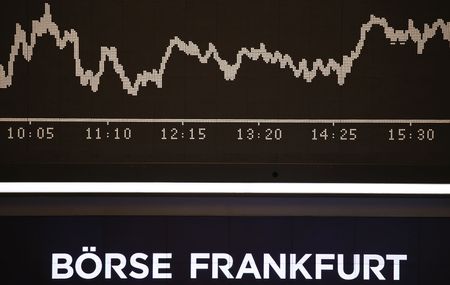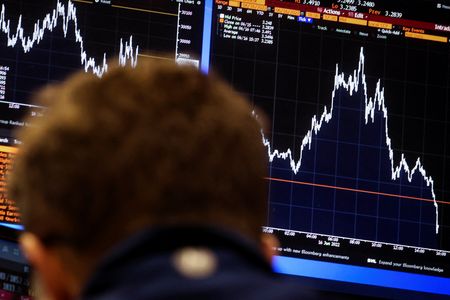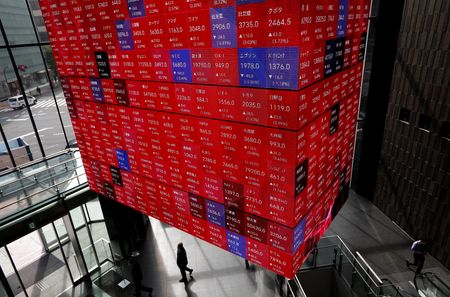


By Koh Gui Qing
NEW YORK (Reuters) – World stocks whipsawed on Friday to edge closer to their worst week since markets’ pandemic meltdown in March 2020, as leading central banks tightened policy in an effort to tame inflation, setting investors on edge about future economic growth.
The biggest U.S. rate rise since 1994, the first such Swiss move in 15 years, a fifth rise in British rates since December and a move by the European Central Bank to bolster the indebted south all took turns in roiling markets.
The Bank of Japan was the only outlier in a week where money prices rose around the world, sticking with its strategy of pinning 10-year yields near zero on Friday.
After a week of punchy moves across asset classes, world stocks were down 0.7% on Friday to take weekly losses to over 6%, and leave the index on course for the steepest weekly percentage drop in more than two years.
By late morning in New York, The Dow Jones Industrial Average fell 0.85%, the S&P 500 lost 0.73%, and the Nasdaq Composite was flat.
“(The) first-half (of) 2022 has not gone according to plan. Inflation, the war and lockdowns in China have derailed the global recovery,” economists at Bank of America said in a note to clients, adding that they see a 40 percent chance of a recession in the United States next year as the Federal Reserve continues to raise rates.
“Our worst fears around the Fed have been confirmed: they fell way behind the curve and are now playing a dangerous game of catch up. We look for GDP growth to slow to almost zero, inflation to settle at around 3% and the Fed to hike rates above 4%.”
Fears that the Fed’s policy tightening could bring about a recession slowed the rise in U.S. yields and supported Treasury prices. Yields fall when prices rise. Ten-year Treasury yields retreated to 3.2483%, from 3.305%. [US/]
Southern European bond yields dropped sharply on Friday, though, after reports of more detail from ECB President Christine Lagarde over its plans to develop a tool to support yields.
“The more aggressive line by central banks adds to headwinds for both economic growth and equities,” said Mark Haefele, Chief Investment Officer at UBS Global Wealth Management. “The risks of a recession are rising, while achieving a soft landing for the U.S. economy appears increasingly challenging.”
In Asia, MSCI’s broadest index of Asia-Pacific shares outside Japan fell to a five-week low, dragged by selling in Australia. Japan’s Nikkei fell 1.8% and headed for a weekly drop of almost 7%.
JITTERS
Bonds and currencies were jittery after a rollercoaster week.
Overnight in Asia, the yen tanked after the Bank of Japan bucked a wave of policy tightening and stuck to its ultra-accomodative policy stance. The yen fell 2.4% by late morning in New York, and the drop in the yen bolstered the U.S. dollar, which rose 0.9% against a basket of major currencies.
Sterling fell 1.2% on Friday in New York as investors focused on the gap between U.S. and UK rates, where the former is helped by the Fed’s current aggressive stance, whereas the Bank of England is opting for a more moderate approach.
“If a central bank does not move aggressively, yields and risk price in more in the way of rate hikes down the road,” said NatWest Markets’ strategist John Briggs.
“Markets may just be continuously adjusting to an outlook for higher global policy rates … as global central bank policy momentum is all one way.”
Growth fears walloped oil prices. U.S. crude recently fell 5.4% to $111.24 per barrel and Brent was at $114.13, down 4.74% on the day.
Gold was off 0.8% at $1,841.38 an ounce, weighed down by a firmer dollar.
(Editing by Lincoln Feast, Angus MacSwan and David Evans)

